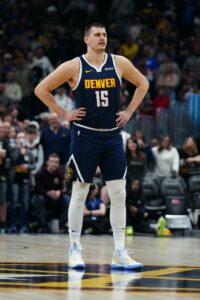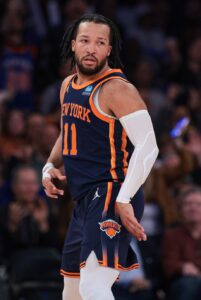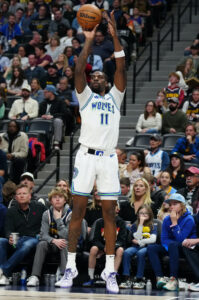With all 30 NBA teams enjoying a day off on Saturday, we have just one day of regular season games remaining in 2023/24, with 15 games on Sunday’s slate.
Amazingly, through 81 games, only three playoff seeds have been determined — the Celtics own the No. 1 seed in the East, the Clippers control No. 4 in the West, and the Mavericks are No. 5 in the West.
We also know that the Bulls are locked into the No. 9 spot in the East and will host the No. 10 Hawks in one of next week’s play-in games.
Besides that though, 15 of the 20 total top-10 seeds in the two conferences remain up for grabs, with much to be determined based on Sunday’s results.
Here’s a look at the matchups to watch and the scenarios in play on Sunday:
Western Conference
Battle for the No. 1 seed:
 The Nuggets were in the driver’s seat for the top spot in the West, but as Bennett Durando of The Denver Post writes, they fell victim to another monster night from Spurs phenom Victor Wembanyama on Friday, blowing a 23-point lead and falling all the way to third place in the conference standings as a result of a disappointing loss in San Antonio.
The Nuggets were in the driver’s seat for the top spot in the West, but as Bennett Durando of The Denver Post writes, they fell victim to another monster night from Spurs phenom Victor Wembanyama on Friday, blowing a 23-point lead and falling all the way to third place in the conference standings as a result of a disappointing loss in San Antonio.
The Thunder and Timberwolves are now tied with Denver in the standings. All three teams have 56-25 records, but Oklahoma City holds the three-way tiebreaker, with Minnesota taking the second spot over the Nuggets for now. Their Sunday matchups are as follows:
- Phoenix Suns at Minnesota Timberwolves
- Denver Nuggets at Memphis Grizzlies
- Dallas Mavericks at Oklahoma City Thunder
If all three teams win or all three lose on Sunday, the current order in the standings (OKC at No. 1, Minnesota at No. 2, and Denver at No. 3) will remain as is. Here are the other scenarios in play on Sunday:
- A Timberwolves win paired with either a Nuggets loss or a Thunder loss would give Minnesota the No. 1 seed, since the Wolves hold the head-to-head tiebreaker over both teams.
- The only scenario in which the Timberwolves would fall to No. 3 would be if they lose and the Thunder and Nuggets both win. That’s not inconceivable, given that Minnesota has the toughest matchup of the three — the Suns still have something to play for, whereas the Mavs’ playoff seed is assured and the Grizzlies are lottery-bound.
- A Thunder win will ensure they claim the No. 1 seed unless the Nuggets lose and the Timberwolves win. The Thunder can fall to No. 3 only if they lose and the Nuggets win, regardless of what happens with Minnesota.
- The Nuggets can only claim the No. 1 seed it they win and the Timberwolves and Thunder both lose. They could move up to No. 2 with a win as long as one of OKC or Minnesota loses. Otherwise they’ll place third.
The final top-six spot:
It’s down to the Pelicans and the Suns for the No. 6 spot in the West. Whichever team misses out on the final guaranteed playoff spot will finish seventh and will host the No. 7 vs. 8 play-in matchup.
New Orleans (49-32) has a one-game lead over Phoenix (48-33), but the Suns hold the tiebreaker edge. The Suns’ only path to No. 6 is to pick up a win in Minnesota while the Pelicans lose at home to the Lakers. Either a Pelicans win or a Suns loss would lock New Orleans into No. 6 and Phoenix into No. 7.
Given that both the Wolves and Lakers still have something to play for on Sunday, this outcome is far from certain.
The Nos. 8 through 10 seeds:
The Lakers (46-35), Kings (45-36), and Warriors (45-36) could each end up anywhere from No. 8 to 10 in the West depending on how the final day’s games play out.
The drop-off from each spot to the next is significant — the eighth-place team will only have to win one of two play-in games to earn a playoff berth and would get the second game at home if it loses the first one on the road. The ninth-place team would have to win two play-in games – one at home and one on the road – just to earn the No. 8 playoff seed, while the 10th-place team would need to win a pair of play-in contests on the road to claim that No. 8 seed.
The Lakers control their own destiny due to their one-game lead on Sacramento and Golden State, but they also have the most difficult matchup of the three teams on Sunday. Those games are as follows:
- Los Angeles Lakers at New Orleans Pelicans
- Portland Trail Blazers at Sacramento Kings
- Utah Jazz at Golden State Warriors
New Orleans pulled out a big win over Golden State on Friday in a game that Klay Thompson said “stings a lot,” per Anthony Slater of The Athletic. The Pelicans won’t be letting their foot of the gas on Sunday as they look to secure a top-six seed, so a Lakers loss is in play.
If the Lakers do lose and both the Kings and Warriors win, Sacramento would move up to No. 8 and Golden State would move up to No. 9, sending L.A. to No. 10. That’s the only scenario in which the Lakers could slip to tenth place. A win would earn them the No. 8 spot, as would all three teams losing. They’d drop to No. 9 if they lose and just one of the Kings or Warriors wins.
The Kings are in relatively good shape. A win over the lottery-bound Blazers, which seems like a relatively safe bet, will assure them of at least the No. 9 spot. They’d fall to No. 10 only if they lose and Golden State wins.
The Warriors’ only path to No. 8 would involve a Golden State win combined with Lakers and Kings losses. That might be a long shot, so it’s perhaps not surprising that head coach Steve Kerr left the door open to possibly resting some key veterans on Sunday to make sure those banged-up players are ready for the first play-in game next week (Twitter link via Slater).
Eastern Conference
Battle for the No. 2 seed:
The reeling Bucks (49-32) have lost seven of their last 10 games, opening the door for either the Knicks (49-32) or Cavaliers (48-33) to steal away the No. 2 seed.
 Still, Milwaukee remains at the front of this race. The Bucks own the tiebreaker over the Knicks, so they just need a win – or for all three teams to lose – in order to clinch No. 2. Unfortunately, they’re missing superstar forward Giannis Antetokounmpo and have the most challenging matchup of any of the three contenders for No. 2. Sunday’s games are as follows:
Still, Milwaukee remains at the front of this race. The Bucks own the tiebreaker over the Knicks, so they just need a win – or for all three teams to lose – in order to clinch No. 2. Unfortunately, they’re missing superstar forward Giannis Antetokounmpo and have the most challenging matchup of any of the three contenders for No. 2. Sunday’s games are as follows:
- Milwaukee Bucks at Orlando Magic
- Chicago Bulls at New York Knicks
- Charlotte Hornets at Cleveland Cavaliers
The Magic continue to battle for a top-six seed in the East, whereas the Bulls are locked into No. 9 and the Hornets are a non-playoff team.
If the Knicks and Cavaliers win and the Bucks don’t, New York would move up to No. 2, Cleveland would take No. 3, and Milwaukee would slide all the way to No. 4. The Bucks could salvage the No. 3 seed even if they lose, as long as at least one of the Knicks or Cavs also lose.
A worst-case scenario for the Knicks would be a three-team tie, which would occur if they and the Bucks lose and the Cavs win. In that case, Cleveland would be No. 2 and New York would slip to No. 4.
Mayhem in the No. 5-8 range:
No section of the standings is more up in the air entering Sunday’s action than the fifth through eight seeds in the East, where four teams – the Magic (46-35), Pacers (46-35), Sixers (46-35), and Heat (45-36) – could all still finish anywhere from No. 5 to 8.
Before we try to untangle this convoluted knot, let’s take a look at the relevant Sunday games:
- Milwaukee Bucks at Orlando Magic
- Atlanta Hawks at Indiana Pacers
- Brooklyn Nets at Philadelphia 76ers
- Toronto Raptors at Miami Heat
All four clubs are at home, but some of these matchups are more favorable than others. The Nets and Raptors are lottery teams who don’t have anything to play for, so it’s hard to imagine them upsetting the Sixers or Heat, respectively. That will put pressure on the Magic and Pacers, who would hang onto the No. 5 and No. 6 seeds if they both win on Sunday.
As detailed above, Milwaukee is trying to clinch the No. 2 seed and will be motivated to beat Orlando. Atlanta is locked into No. 10, but knocking off Indiana could benefit the Hawks, who will need to beat one of these teams to make the playoffs, assuming they make it past Chicago. Atlanta might prefer seeing the Pacers instead of the Sixers or Heat in a play-in battle next week — beating Indiana on Sunday would increase the odds of that.
There are too many scenarios in play here to run through them all, but here are a few worth mentioning:
- The Sixers would move up to No. 5 if they beat Brooklyn and the Hawks beat Indiana.
- The Pacers would move up to No. 5 if they beat Atlanta and the Bucks beat Orlando.
- The Heat can only get to No. 5 if they win and the Magic, Pacers, and Sixers all lose, resulting in a four-way tie. They could move up to No. 6 if they win, the Magic lose, and one of the Pacers or Sixers lose.
- The Magic would fall to No. 8 if they lose and the Heat and Pacers win, regardless of what happens in the Sixers game. Orlando could also end up at No. 8 if Miami is the only one of these teams to win and they end up in a four-way tie.
- The only scenario in which the Pacers could fall to No. 8 is if they lose and the Magic, Sixers, and Heat all win. Like the Magic, they’ll clinch a top-six playoff berth with a win.
The full table of Eastern Conference scenarios can be found right here, per the NBA, while all the Western outcomes are here.
We want to know what you think. How do you expect Sunday’s games to play out? Which teams will take the No. 1 seed in the West and the No. 2 seed in the East? Which clubs will claim the final playoff spots in each conference? And which team of the Lakers, Kings, and Warriors will end up in the 7-8 game instead of 9-10?
Head to the comment section below to make your predictions!
 The NBA’s schedule-makers did well with Friday’s slate — the Magic will face the Sixers in Philadelphia, while the Cavaliers host the Pacers in Cleveland.
The NBA’s schedule-makers did well with Friday’s slate — the Magic will face the Sixers in Philadelphia, while the Cavaliers host the Pacers in Cleveland. Nuggets center
Nuggets center  Bey, Maxey, and Quickley would have had qualifying offers worth $6,498,258, $6,259,588, and $6,128,004, respectively, if they had fallen short of the starter criteria. Instead, their QOs will each be worth $8,486,620.
Bey, Maxey, and Quickley would have had qualifying offers worth $6,498,258, $6,259,588, and $6,128,004, respectively, if they had fallen short of the starter criteria. Instead, their QOs will each be worth $8,486,620. As a former No. 2 overall pick, Wiseman would have been in line for a qualifying offer worth $15,815,870 if he had made at least 41 starts or played 2,000 minutes. Because he fell short, his actual QO will be worth less than half that ($7,744,600).
As a former No. 2 overall pick, Wiseman would have been in line for a qualifying offer worth $15,815,870 if he had made at least 41 starts or played 2,000 minutes. Because he fell short, his actual QO will be worth less than half that ($7,744,600). A top-14 pick who does not meet the starter criteria will receive a qualifying offer equal to the amount the 15th overall pick would receive if he signed for 120% of the rookie scale.
A top-14 pick who does not meet the starter criteria will receive a qualifying offer equal to the amount the 15th overall pick would receive if he signed for 120% of the rookie scale.
 The 2024 draft lottery will be the sixth one employing the format that was
The 2024 draft lottery will be the sixth one employing the format that was